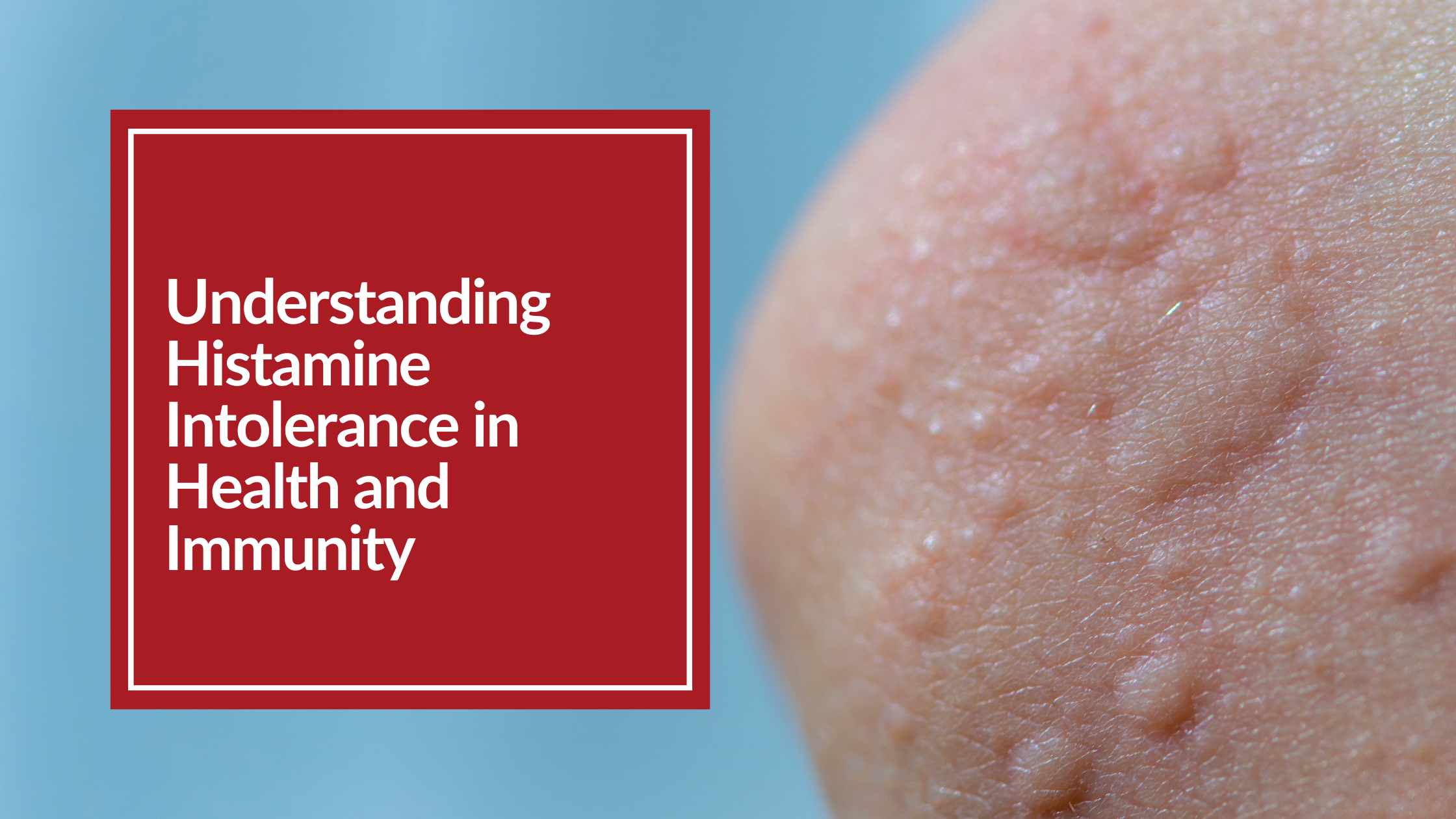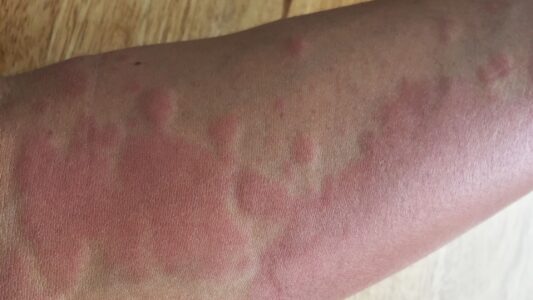
Understanding histamine intolerance begins with understanding what histamine is.
Histamine plays a crucial role in various physiological and pathological processes. It’s involved in immune responses, inflammation, allergy reactions, and even neurotransmission in the brain. Histamine’s effects can be a double-edged sword. While it helps protect the body against potential threats, its consumption, or overconsumption of certain foods, can trigger a series of health issues, such as histamine intolerance and possibly Mast Cell Activation Syndrome (MCAS).
This article will help you understand histamine intolerance by exploring its functions, its potential health implications, and how managing histamine levels can contribute to overall health and well-being.
What is Histamine?
Histamine is a chemical compound known as a biogenic amine. It can be in many foods, and in the body. Histamine is stored in mast cells and basophils, two types of immune cells that are widely distributed throughout the body. Upon stimulation, these cells release histamine, triggering various physiological responses.
Histamine is associated with several bodily functions, including:
- the regulation of gastric acid secretion,
- smooth muscle contraction
- neurotransmission (carrying signals from one nerve to another) in the central nervous system
However, its most notable role is in the body’s immune response, particularly in inflammation and allergic reactions. Histamine can activate Respiratory System issues like bronchoconstriction, where your bronchial tubes that lead into your lungs may swell or spasm. You may also find an increased output of saliva, or that you may itch (1).
If you’ve had an itchy mosquito bite, that histamine is making the skin go red (vasodilation), swell and itch!
Histamine gets broken down in the body by amine oxidases. DAO or diamine oxidase is the main enzyme to metabolize ingested histamine (1). If someone struggles with histamine intolerance, then they may have low DAO activity. Another enzyme histamine N-methyltransferase works in the cell to convert or break down histamine. Low activity of this may also be part of histamine intolerance. The main focus for histamine intolerance is DAO.
Understanding Histamine Intolerance vs Histamine Intoxication
Histamine intoxication comes from ingesting foods with high levels of histamine, whereas histamine intolerance comes from the inability to break histamine down. Histamine intoxication used to be called scombroid fish poisoning or scombrotoxicosis. According to the Minnesota Department of Health, this condition is associated with fish from this family, the scromboids, and it includes mackerel, bonita, tuna and skipjack.
Histamine Receptors
Histamine receptors are located in many areas of the body, in the Nervous system, the heart, the lungs, the Digestive System, the Immune System and even in the adrenals (1). There are 4 types of histamine receptors.
H1R, H2R, H3R, and H4R.
Histamine in Immune Response and Inflammation
Histamine is your first responders when the Immune System detects a potential threat, such as an allergen, pathogen, or injury. Histamine release leads to the classic symptoms of inflammation: redness, heat, swelling, and pain.
Role in Innate Immunity
Histamine contributes to innate immunity, the body’s first line of defense against pathogens. It promotes the recruitment and activation of immune cells, such as neutrophils and eosinophils, to the site of infection or injury. Histamine also enhances the functional capacity of antigen-presenting cells (APCs), key players in immune responses.
Through its interaction with H1R, histamine can induce the production of nitric oxide and prostacyclins, two potent vasodilators. This causes the blood vessels to dilate and become more permeable, allowing immune cells and proteins to access the affected area.
Role in Adaptive Immunity
Histamine is also involved in adaptive immunity, the immune response tailored to specific pathogens. It influences the function of dendritic cells (DCs), the APCs that link innate and adaptive immunity. Histamine can potentiate antigen endocytosis and promote the expression of major histocompatibility complex (MHC) class II molecules, enhancing the antigen-presenting capacity of DCs.
Histamine can also affect T cell responses. T cells are a white blood cell of the immune system, also called lymphocytes. Activation of H1R promotes the generation of a specific branch of the Immune System called the Th1 response. This is critical for defending against intracellular pathogens. On the other hand, H2R regulates Th2 responses, which are involved in allergic reactions and defense against parasites.
Amanda Panacea, one of our practitioners teaches the branches of the Immune System in our Bioenergetic Certification Course. She shares that Th2 is where Mast Cells release basophils. Basophils are another type of white blood cell involved in your Immune response, to defend against pathogens and allergens.
Understanding Histamine Intolerance and Allergies
Allergic reactions are perhaps the most well-known manifestation of histamine activity. When the immune system encounters an allergen, it triggers a cascade of events leading to the activation of mast cells and basophils and the subsequent release of histamine.
Histamine binds to its receptors on various cells, causing vasodilation, increased vascular permeability, and smooth muscle contraction. These effects result in the typical symptoms of an allergic reaction, such as itching, redness, swelling, sneezing, and difficulty breathing. In severe cases, it can lead to anaphylaxis, a life-threatening allergic reaction that requires immediate medical attention.
Histamine Intolerance and Mast Cell Activation Syndrome are two other conditions that look like an allergy. They can be triggered by foods, alcohol, drugs, mold and may also be present with Lyme.
Understanding Histamine Intolerance and Mast Cell Activation Syndrome (MCAS)
While histamine is vital for normal immune function, its overproduction or the body’s inability to break it down can lead to health issues. Histamine intolerance and Mast Cell Activation Syndrome (MCAS) are two conditions related to abnormal histamine activity.
Histamine Intolerance
Histamine intolerance results from an imbalance between the body’s histamine load and its capacity to metabolize histamine. This can occur due to excessive intake of histamine-rich foods, reduced activity of histamine-degrading enzymes, or increased release of histamine from mast cells and basophils.
People with histamine intolerance may experience:
- Headaches
- Skin irritation
- Diarrhea
- Nasal congestion
- Asthma
- Irregular menstrual cycle
- Hypotension
These symptoms often mimic those of an allergic reaction, but they persist as long as the histamine imbalance remains.
What causes histamine intolerance? Some medications may degrade the enzyme that breaks down histamine.
CBH Energetics never advises a client to stop their medications. In fact, we always want you to seek help from a licensed care practitioner if you suspect you have a health or mental health issue.
Some health conditions may also contribute to histamine intolerance.
Mast Cell Activation Syndrome (MCAS)
MCAS is a condition where mast cells become hyper-responsive and release excessive amounts of histamine and other mediators. This excessive release can lead to a plethora of symptoms affecting various systems, including the skin, gastrointestinal tract, cardiovascular system, respiratory system, and nervous system.
Symptoms of MCAS can include:
- Flushing
- Itching
- Abdominal pain
- Nausea
- Vomiting
- Diarrhea
- Low blood pressure
- Rapid heartbeat
- Shortness of breath
There may even be cognitive difficulties. Because these symptoms are nonspecific and can mimic other conditions, MCAS is often overlooked.

Managing Histamine Intolerance
Given the wide-ranging effects of histamine in the body, maintaining a balanced histamine level is crucial for those with chronic illness. Creating balanced health can be worked on through a combination of diet, lifestyle modifications, medical treatments and holistic remedies.
Low-Histamine Diet
A low-histamine diet eliminates foods rich in histamine and other biogenic amines. These include fermented foods, aged cheeses, alcohol, certain types of fish, and processed meats. Fresh fruits and vegetables, fresh meat, and certain types of dairy are typically well-tolerated.
It’s important to note that histamine tolerance can vary greatly from person to person. What may trigger symptoms in one person may be perfectly safe for another. Therefore, it’s essential to work closely with a practitioner that can help you understand your body while you figure out what foods work for you, and what foods don’t.
Medications and Supplements
Antihistamines can be a help when someone is trying to function and figure out the root causes of their histamine intolerance or MCAS. These medications block the action of histamine at its receptors, thereby preventing or alleviating histamine-induced symptoms. There are different types of antihistamines targeting different histamine receptors, and they can be used to manage a variety of conditions, from allergies to gastrointestinal disorders.
Certain supplements may help manage histamine levels as well. For instance, vitamin C and quercetin have been found to stabilize mast cells and prevent histamine release. Probiotics, particularly certain strains of Bifidobacterium and Lactobacillus, can degrade histamine in the gut, potentially reducing histamine load. Vitamin B6 and copper may also help with histamine intolerance.
Lifestyle Modifications
Stress management is a crucial component of histamine management. Stress can trigger mast cell activation and histamine release, leading to a flare-up of symptoms. Therefore, incorporating stress-reducing activities into your daily routine, such as mindfulness meditation, yoga, or deep breathing exercises, can be beneficial.
Regular exercise can also help manage histamine levels. Exercise boosts the immune system, improves gut health, and reduces stress, all of which can contribute to balanced histamine levels. However, it’s important to note that intense physical activity can trigger histamine release, so it’s important to find a balance that works for your body.
Your Takeaways for Understanding Histamine Intolerance
Histamine plays an integral role in the body’s immune response and inflammation process. However, an imbalance in histamine levels can lead to various health issues, from allergies to histamine intolerance and Mast Cell Activation Syndrome (MCAS). By understanding how histamine works and how it affects our health, we can better manage our histamine levels, creating balanced health and well-being.
Whether you’re navigating the complexities of histamine intolerance or MCAS, or simply wanting to understand your body better, consider looking at your diet, and limit or take out alcohol. To look for deeper connections, in Vitamins like Vitamin C or minerals like Copper, a Full Scan will show you your imbalances and resonating toxins that might be a contributor to your issues!
Sources:
https://ajcn.nutrition.org/article/S0002-9165(23)28053-3/fulltext
https://www.sciencedirect.com/topics/neuroscience/histamine-receptor#:~:text=Histamine%20receptors%20are%20G%2Dprotein,cells%2C%20and%20the%20adrenal%20medulla.
DISCLAIMER: Balanced Health, LLC/CBH Energetics and any parent, subsidiary, affiliated or related entities and companies do not provide medical advice or services. This post and the bioenergetic products and services offered by Balanced Health, LLC/CBH Energetics including, but not limited to, bioenergetic tests, bioenergetic scans, bioenergetic reports and related products and services (collectively the “Bioenergetic Products and Services”) are designed for educational and informational purposes only and are not intended to diagnose, treat, cure, or prevent any disease, condition, complaint, illness or medical condition and are not a substitute for professional services or medical advice.
